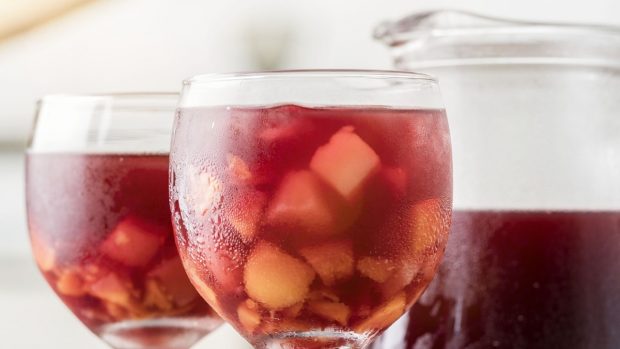If you thought that sangría was a Spanish invention, then think again. The “refreshing drink which combines wine and water with sugar and lemon and other complements”, as it is defined in the official Spanish dictionary(RAE), is British. Well, the name is... Yes, I was just as surprised when I found out!
The British sangría has been known about since 1987 when the philologist Francisco Marcos Álvarez, divulged to the Spanish Language History Congress (Cáceres) that the word sangría comes from 'sangaree', a drink enjoyed by the British residents of the British West Indies and some other North American colonies back in the seventeenth century. When British ex-pats are demanding sangría on the terrace of a local bar they are unwittingly using an Anglicism.
Sangaree, back in 1694 on the island of Martinique, was made with “Madeira wine mixed in a jug with sugar, the juice from a lemon, a little cinnamon and powdered clove, plenty of nutmeg and a crust of toast”. This drink was described by the Frenchman Jean-Baptiste Labat in his book 'Nouveau voyage aux isles de l'Amérique' (1722), who tasted the concoction on his trip to the British Antilles and declared that once strained and chilled, it was delicious and refreshing.
This 'sangaree', made with wine from Madeira, Porto or the Canary Islands (sometimes also with rum), was a very popular drink in the colonies of Barbados, Bahamas and Virginia throughout the seventeenth and eighteenth centuries. From the English 'sangaree', Labat understood 'sang-gris', a term that passed via Chinese whispers to Spanish as 'grey blood' thanks to Esteban Terreros and his 'Diccionario Castellano con las voces de ciencias y artes' (1788). He defined it as “a beverage that the English invented and is often drunk in the English and French colonies of America: the English say that it refreshes because it contains some lemon juice or citron [...] but that it goes quickly to the head proves that this drink contains a lot of spirit and a lot of fire”.
In 1803, the RAE would veto 'grey blood' and would choose to include a new meaning for the word sangría: “a drink that is composed of water, lemon and red wine”. This meaning stood for decades in Mexico and other Spanish-American countries, probably due to the Caribbean influence, but strangely in Spain, there is no previous mention to 1800, except for “sangrías de vino tinto” served at the Cadiz Carnival in 1770.
Is it that wine and lemon maybe didn't appeal to Spaniards? Of course it did, but until the beginning of the 19th century, that mixture was known here as lemonade. A descendant of the medicinal and spicy wines of the Middle Ages, wine lemonade was one of the most popular drinks of the Golden Age.
Whether served as a soft drink or as a medicine, it was used to treat fever, vomiting and as an anticoagulant measure before bloodletting. However, by the mid-nineteenth century, Spain fervently adopted the term 'sangría' and the old 'lemonade' was abandoned.
In Menorca, the sengri menorquin, without a doubt comes from the English 'sangaree'. The British occupation of the island during the seventeenth century left, among other things, this hot drink made from red wine, sugar, orange, cinnamon, anise, nutmeg and bread, extraordinarily similar to that concoction that over 300 years ago Labat tried in sunny Martinique.
With the passing of time Sangria developed into what we would now consider the 'traditional' recipe. Traditional homemade sangria is typically made with good young red wine and seasonal fruits, both in the form of juice (oranges, lemons) and in pieces to add flavour (peaches and apples). If you fancy making it here are the steps to follow:

Ingredients to prepare homemade sangria (1.5 litres):
1 bottle of good red wine (750 ml) - 'Tinto Joven'
2 peaches
1 apple
2 oranges (variety for juice)
1 lemon for juice
1/2 cinnamon stick.
1 can (330 ml) soda (optional)
2 tablespoons of sugar.
2 tablespoons of water.
- Squeeze the oranges and the lemon, strain their juice and put it in the jug or container where you are going to serve the sangria. Also, add the red wine.
- Peel the apple, core it, cut it into small squares and add them to the jar.
- Do the same with the peaches: peel them, remove the pit, cut them into squares and put them in the jar as well and add the cinnamon stick.
- Now you will need to prepare a small syrup. It is simply a matter of diluting the sugar so that when it is added to the jar it dissolves perfectly and does not remain at the bottom. To do this, put the sugar and water in a saucepan over medium heat for a few minutes until the sugar dissolves. Add it to the jar and stir well.
- Now let it rest at room temperature for a couple of hours, so that the flavours merge and the wine absorbs all the flavour of the fruit. If you are going to drink it more than two hours after preparing it, then you should put it in the refrigerator until it is time to serve it.
- Just before serving, you can add the soda, if you want - it is optional. It is best to put ice in the glasses and not in the jug to avoid diluting it too much.